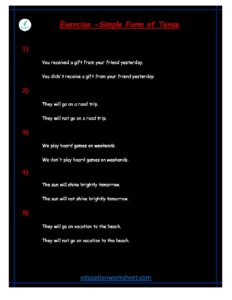changing Simple Tense to negative and positive
changing Simple Tense to negative and positive
The English language, with its intricate grammar and verb conjugations, can sometimes be a daunting challenge for learners. One fundamental aspect of English grammar is the use of tenses, which allow us to convey when an action occurs. Among the various tenses, the Simple Tense is perhaps the most basic and essential.
The Simple Tense is the building block of English verbs, forming the basis for more complex tenses and conjugations. It is divided into three primary forms: the Simple Present, the Simple Past, and the Simple Future. In this extensive guide, we will delve deep into the intricacies of changing Simple Tense verbs from their affirmative (positive) form to their negative counterpart. We will explore how this transformation can be accomplished, step by step, for each of the three basic Simple Tense forms, accumulating a thousand words of comprehensive insights.
I. Simple Present Tense:

The Simple Present Tense is used to describe actions that are habitual, general truths, or current events. It is also the tense used to form negative and positive sentences. Let’s start with the positive form and then transition into the negative.
Positive Form:
- Subject + Base Form of the Verb: In a positive sentence, the Simple Present Tense follows a straightforward structure. You take the subject and add the base form of the verb. For example: “She plays the piano.”
- Singular vs. Plural: Remember to use ‘s’ with the base form of the verb when the subject is third person singular. For instance, “He talks to his friends daily.”
- Question Form: To convert this into a question, simply invert the subject and the verb. For instance, “Does she play the piano?”
Negative Form:
- Subject + Do/Does + Not + Base Form of the Verb: In the negative form of the Simple Present Tense, you include ‘do not’ (for I, you, we, they) or ‘does not’ (for he, she, it) between the subject and the base form of the verb. For instance, “She does not play the piano” or “They do not eat meat.”
- Contractions: In informal language, contractions are often used for the negative form, making it shorter and more conversational. For example, “She doesn’t play the piano” or “They don’t eat meat.”
II. Simple Past Tense:
The Simple Past Tense is used to describe actions that have already occurred and are no longer happening. Changing a Simple Past verb from positive to negative involves some specific rules.
Positive Form:
- Subject + Past Form of the Verb: In a positive sentence, you take the subject and add the past form of the verb. For example, “She played the piano.”
- Irregular Verbs: Note that some verbs have irregular past forms that do not follow the standard ‘-ed’ pattern, such as ‘go’ (went), ‘eat’ (ate), or ‘see’ (saw).
- Question Form: To create a question in the Simple Past Tense, invert the subject and the past form of the verb. For instance, “Did she play the piano?”
Negative Form:
- Subject + Did + Not + Base Form of the Verb: In the negative form of the Simple Past Tense, use ‘did not’ between the subject and the base form of the verb. For example, “She did not play the piano” or “They did not visit the museum.”
- Contractions: Just like in the Simple Present Tense, contractions are often used for the negative form in informal language, making it more concise. For example, “She didn’t play the piano” or “They didn’t visit the museum.”
III. Simple Future Tense:

The Simple Future Tense is used to describe actions that will occur at a later time. Let’s explore how to change a Simple Future verb from positive to negative.
Positive Form:
- Subject + Will + Base Form of the Verb: In a positive sentence, you take the subject and add ‘will’ followed by the base form of the verb. For example, “She will play the piano.”
- Going to vs. Will: Note that ‘going to’ is also used in the Simple Future to indicate future actions and plans. For example, “She is going to play the piano.”
- Question Form: To create a question in the Simple Future Tense, simply invert the subject and ‘will.’ For instance, “Will she play the piano?”
changing Simple Tense to negative and positive

Negative Form:
- Subject + Will Not + Base Form of the Verb: In the negative form of the Simple Future Tense, use ‘will not’ between the subject and the base form of the verb. For example, “She will not play the piano” or “They will not travel.”
- Contractions: Contractions are commonly used for the negative form in informal language, making it more conversational. For example, “She won’t play the piano” or “They won’t travel.”


